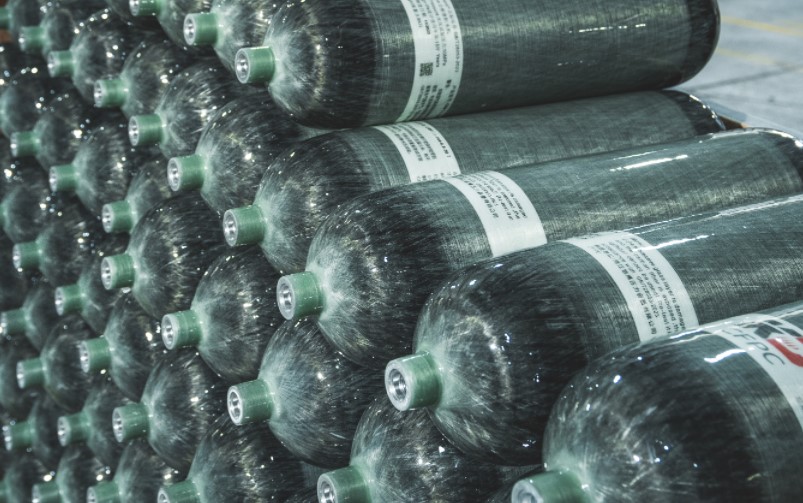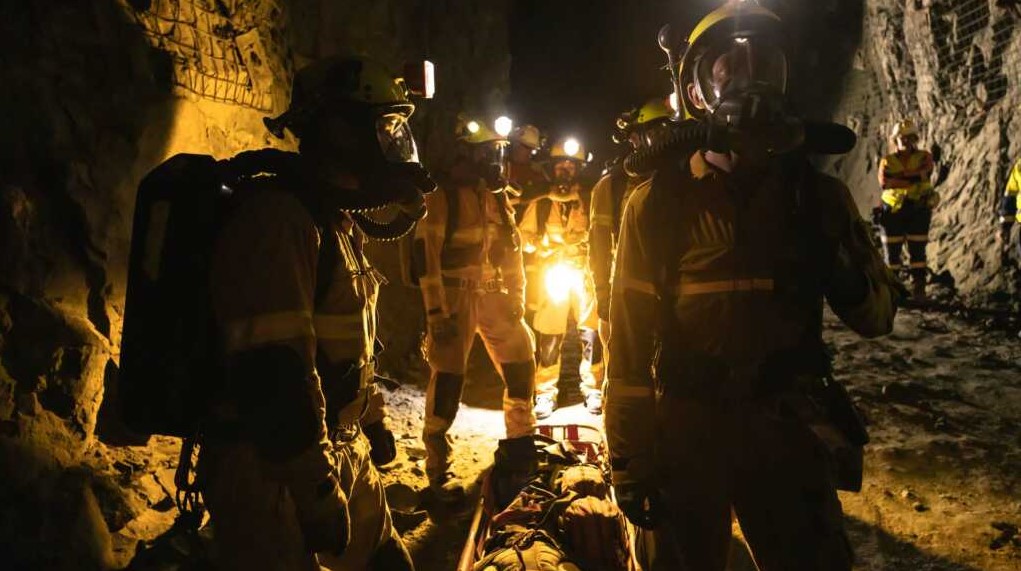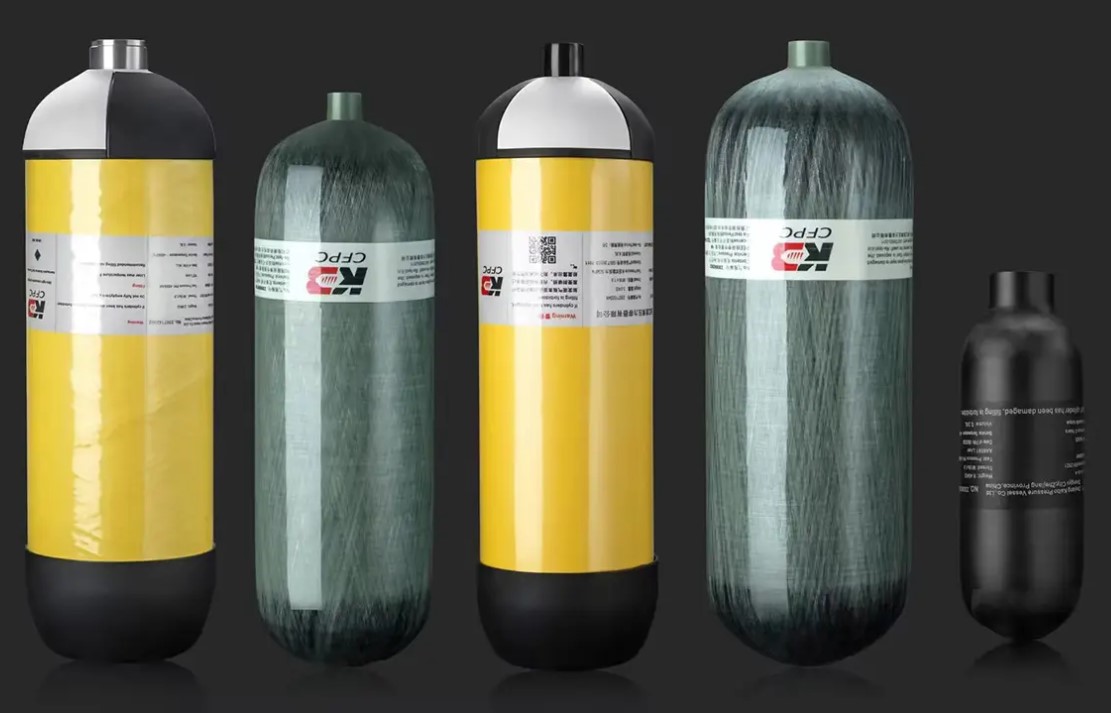Introduction
Mining is a high-risk industry where workers are often exposed to hazardous conditions, including low oxygen environments, toxic gases, and the potential for explosions. Reliable breathing equipment is essential for ensuring worker safety in these extreme conditions. Among the most critical components of this equipment are compressed air cylinders, which supply breathable air to miners in emergencies or during routine operations in oxygen-deficient areas.
Carbon fiber composite cylinders have become the preferred choice over traditional steel or aluminum tanks due to their lightweight structure, high durability, and capacity to store air at higher pressures. This article explores how carbon fiber cylinders work, their advantages in mining applications, and why they are essential for ensuring safety and efficiency underground.
How Carbon Fiber Cylinders Work
Carbon fiber cylinders function as high-pressure storage units for compressed air or breathing gases. These cylinders are commonly used in self-contained breathing apparatus (SCBA), emergency escape breathing devices (EEBD), and other air supply systems that miners rely on in hazardous environments.
1. Structure of a Carbon Fiber Cylinder
A typical carbon fiber composite cylinder consists of multiple layers:
-
Inner Liner: Made of aluminum or plastic, it serves as the primary container for compressed air.
-
Carbon Fiber Reinforcement: The outer shell is wrapped with carbon fiber composite material, providing strength and preventing rupture under high pressure.
-
Resin Coating: This layer protects the cylinder from external damage and wear.
2. Air Compression and Storage
Carbon fiber cylinders can store air at pressures up to 300 bar (4,500 psi), much higher than steel cylinders of the same weight. This allows for longer operational times without increasing the physical burden on the user. The compressed air inside is purified to remove contaminants, ensuring that the air supply remains safe to breathe.
3. Delivery of Breathing Air
The cylinder is connected to a regulator, which reduces the high-pressure air to a breathable level before delivering it to the user through a mask or hood. Some systems include automatic pressure adjustments to ensure a steady air supply even as cylinder pressure decreases.
The Importance of Carbon Fiber Cylinders in Mining Work
Mining operations require a reliable air supply system due to several unique risks:
-
Low Oxygen Levels: Deep underground, natural ventilation is limited, and oxygen levels can drop below safe thresholds.
-
Toxic Gas Exposure: Gases such as carbon monoxide, methane, and hydrogen sulfide can accumulate, making it unsafe to breathe without protective equipment.
-
Explosion and Fire Hazards: Combustible dust and flammable gases increase the risk of fires or explosions, making proper breathing protection vital.
-
Emergency Situations: Collapses, gas leaks, or equipment failures may require miners to use escape breathing devices to reach safety.
In all these scenarios, carbon fiber cylinders provide a crucial air supply, allowing miners to continue working safely or escape hazardous areas.
Advantages of Carbon Fiber Cylinders in Mining
1. Lightweight Design for Reduced Fatigue
Traditional steel cylinders are heavy, making it difficult for miners to carry them for extended periods. Carbon fiber cylinders are up to 50% lighter while holding the same or more air volume. This reduces physical strain and allows miners to work more comfortably, especially in confined underground spaces.
2. Extended Air Supply for Longer Safety Windows
Because carbon fiber cylinders can store air at higher pressures, they provide a longer-lasting air supply than conventional alternatives. This is critical in emergencies where extra minutes of breathable air can make a difference in survival.
3. Corrosion Resistance for Harsh Conditions
Mine environments are often damp, humid, and filled with dust or chemicals that can corrode metal equipment over time. Unlike steel cylinders, carbon fiber cylinders do not rust, ensuring they remain functional for longer periods with minimal maintenance.
4. Impact Resistance for Durability
Mining operations involve rough handling of equipment. Carbon fiber composite materials have high impact resistance, making them less likely to crack or fail due to drops, impacts, or external pressure. This improves overall safety by reducing the risk of cylinder failures in critical moments.
5. Easier Handling in Emergency Situations
In the event of a mine collapse or gas leak, workers need to quickly access their breathing equipment. Lighter and more compact carbon fiber cylinders allow for faster deployment and easier movement, helping miners escape dangerous situations more effectively.
Applications of Carbon Fiber Cylinders in Mining
-
Self-Contained Breathing Apparatus (SCBA):
-
Used by emergency response teams for rescue operations in hazardous conditions.
-
Ensures a steady supply of clean air when oxygen levels are low.
-
-
Emergency Escape Breathing Devices (EEBD):
-
Provides miners with breathable air for a limited period to evacuate safely in case of gas leaks or explosions.
-
Compact and lightweight, making it easy to carry.
-
-
Air Supply for Confined Space Work:
-
Used in maintenance or drilling operations where natural ventilation is inadequate.
-
Ensures workers can breathe safely without relying on external air sources.
-
-
Mobile Breathing Stations:
-
Installed in underground shelters or escape routes for extended air supply in emergencies.
-
Helps miners survive while awaiting rescue.
-
Maintenance and Safety Guidelines for Carbon Fiber Cylinders
To ensure the longevity and safety of carbon fiber cylinders in mining applications, proper maintenance is essential:
-
Regular Inspections: Check for external damage, wear, or leaks before each use.
-
Hydrostatic Testing: Follow manufacturer guidelines for periodic pressure testing to confirm structural integrity.
-
Proper Storage: Keep cylinders in dry, cool areas away from chemicals or sharp objects that could compromise the fiber wrap.
-
Valve and Regulator Maintenance: Ensure proper functioning of valves and air flow regulators to avoid pressure drops or air loss.
-
Training for Workers: All users should be trained on proper handling, emergency procedures, and recognizing early signs of equipment failure.
Conclusion
Carbon fiber cylinders have become a vital part of modern mining safety equipment, providing a reliable air supply for workers in hazardous underground conditions. Their lightweight design, high-pressure storage capacity, and durability make them superior to traditional metal cylinders. By reducing worker fatigue, extending air supply duration, and offering greater resistance to harsh environments, these cylinders improve both safety and operational efficiency in the mining industry.
As technology advances, carbon fiber cylinders will continue to play an essential role in protecting miners and ensuring safer working conditions deep underground. By investing in high-quality equipment and maintaining proper safety protocols, mining companies can better safeguard their workers and prevent respiratory hazards in the field.
Post time: Mar-31-2025



